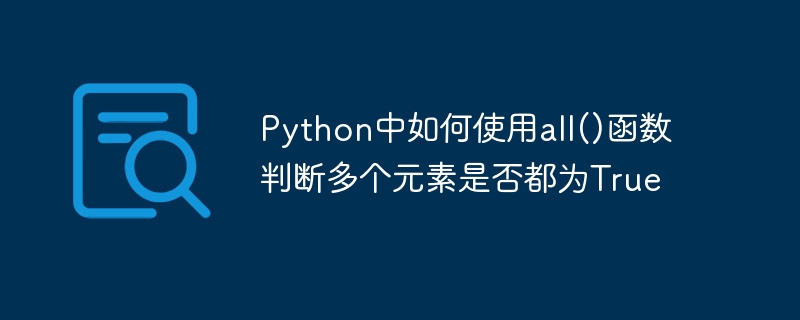

How to use the all() function in Python to determine whether multiple elements are True
When writing Python programs, you often encounter the need to determine whether multiple elements are True all meet certain conditions. Python provides a very convenient function all() to achieve this function. This article will introduce in detail how to use the all() function to determine whether multiple elements are True, and give corresponding code examples.
The all() function is one of Python's built-in functions. It accepts an iterable object as a parameter and returns a Boolean value. It returns True when all elements in the parameter are True; otherwise it returns False.
Below we use a few simple examples to illustrate how to use the all() function.
First, let’s look at an example of using the all() function to determine whether all elements in the list are True:
numbers = [2, 4, 6, 8, 10] result = all(num % 2 == 0 for num in numbers) print(result) # 输出 True
In the above code, we first define a list containing some numbers list of numbers. We then use the generator expression num % 2 == 0 for num in numbers to determine whether each element in the list is an even number. Finally, we pass the generator expression as a parameter to the all() function and assign the returned result to the variable result. Finally, we output the value of the variable result, and we can see that the result is True, which means that all elements in the list are even numbers.
Next, let’s look at an example of using the all() function to determine whether all characters in a string are letters:
string = "Hello World!" result = all(char.isalpha() for char in string) print(result) # 输出 False
In the above code, we define a string string, which contains some alphabetic and some non-alphabetic characters. We then use the generator expression char.isalpha() for char in string to determine whether each character in the string is a letter. Finally, we pass the generator expression as a parameter to the all() function and assign the returned result to the variable result. Finally, we output the value of the variable result, and we can see that the result is False, indicating that not all characters in the string are letters.
In addition to lists and strings, we can also use the all() function to determine whether the elements in other iterable objects (such as tuples, sets, etc.) meet a certain condition.
To summarize, using the all() function can easily determine whether multiple elements are True. It accepts an iterable object as parameter and returns a boolean value. It returns True when all elements in the parameter are True; otherwise it returns False. Through a few simple examples, we show how to use the all() function to determine whether the elements in lists, strings, and other iterable objects meet a certain condition.
I hope the explanation in this article can help you understand the usage of the all() function and be able to apply it flexibly in subsequent programming work.
The above is the detailed content of How to use the all() function in Python to determine whether multiple elements are True. For more information, please follow other related articles on the PHP Chinese website!




